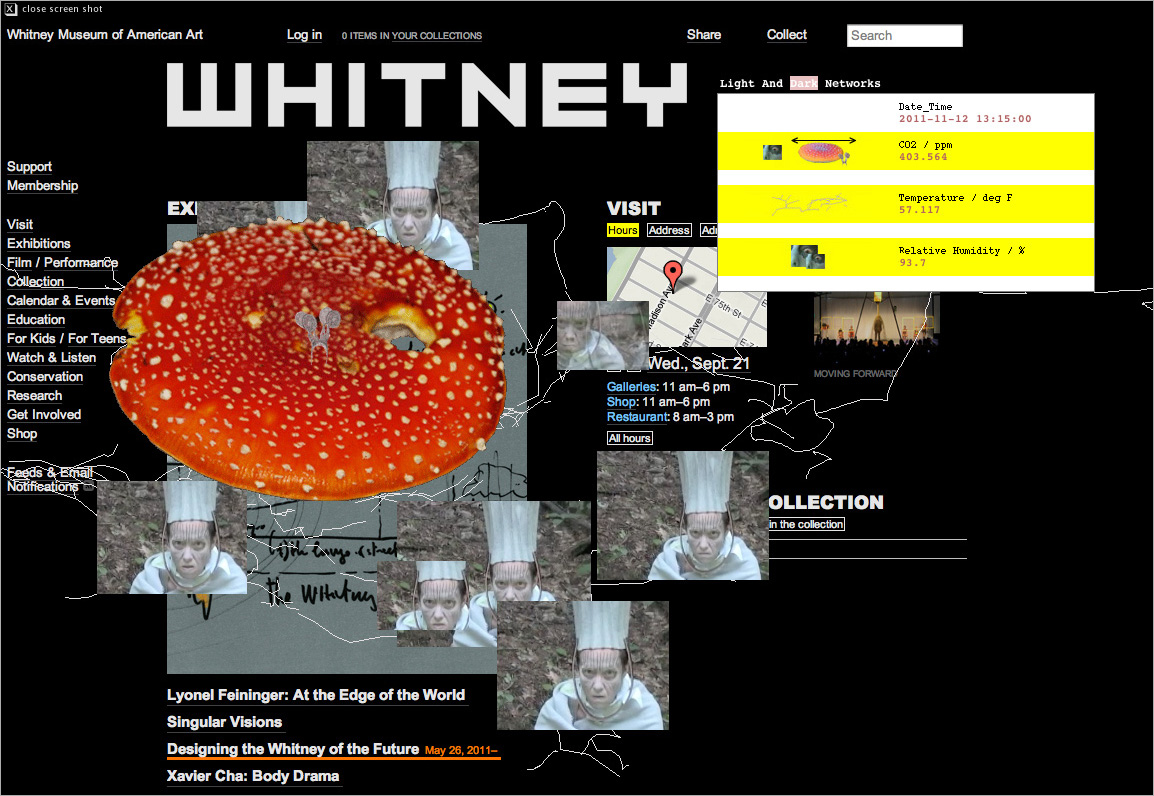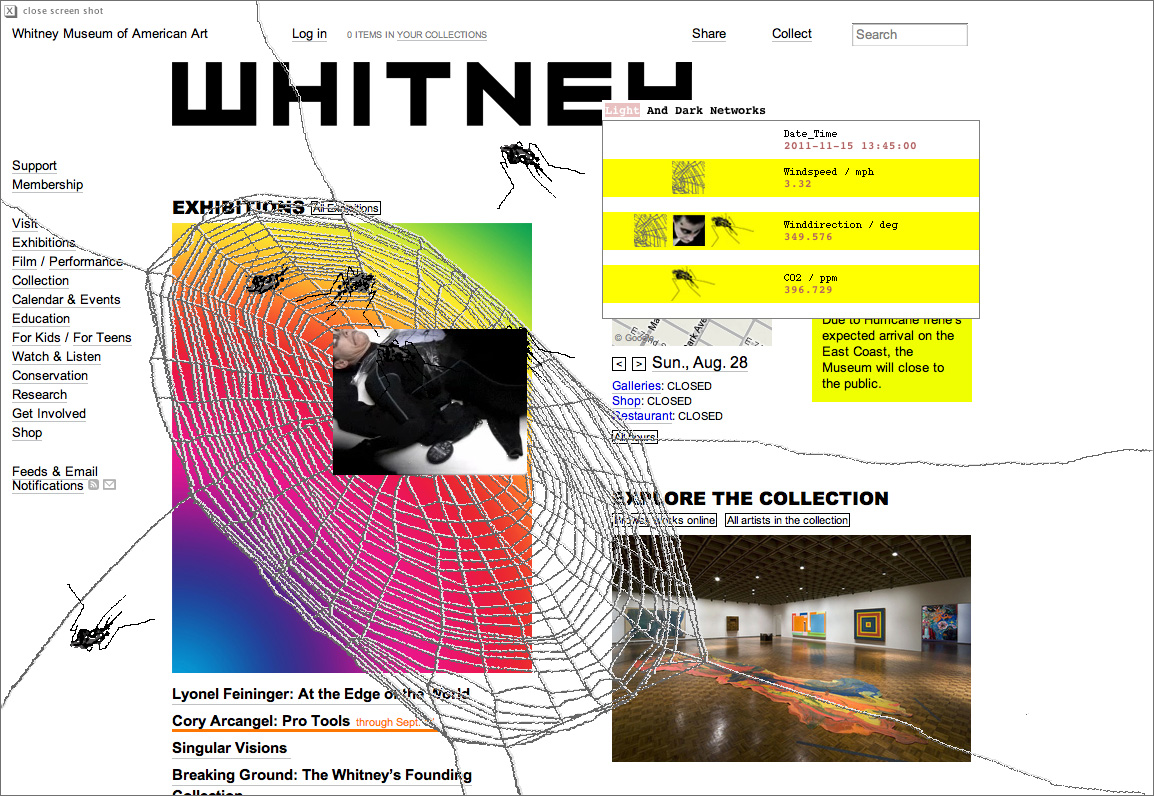Project Notes:
Light and Dark Networks consists of two online data performances taking place at whitney.org during sunrise and sunset in New York City, and are directed by actual weather and environmental changes in the
New York City area.
The two performances are inspired by the structures of natural networks: one aboveground (spiderweb), the other one underground (mycelium).
The piece looks at networks as living organisms - be it spider webs, mycelium, or the Internet - constantly changing by different artificial or natural parameters.
Taking a closer look at the nature of the Internet itself this piece playfully examines how our physical and virtual existence is embedded in networks...
I am extremely happy having been able to produce this piece. I first thought about creating a piece that is inspired by the "morphological" parallels of naturally occurring networks versus artificially built
networks in 1998 after having already developed a couple of net art works. I contemplated about different forms of networks, be they mycelium, canal systems, spiderwebs, or the Internet. So, finally, almost
a decade and a half later, the piece came to fruition. Also, the Sunrise and Sunset series at Whitney.org proved to be the perfect environment for this piece. I am very happy that Christiane Paul encouraged the development of
"Light and Dark Networks". Yet another factor that has driven the development of this piece is that both, spiders and mushrooms, have very personal connotations for me. But more details about this below...
+ + + + + + + + + + + + + + + + + + + + + + + + + + + + +
Dark Network: Mycelium (@ Sunset)
We are invited to a mushroom's mycelium at nightfall and witness the phenomena within and around this network. The virtual creatures (mushrooms characters played by myself) are performing different "data dances"
according to the changes in their habitat, which are defined by New York City weather and CO2 levels.
Humidity levels will encourage more mushrooms (=mushroom videos) to grow from the mycelium which is stretched across the museum's website. The mycelium will be larger or smaller
depending on rising and falling of temperature.
Carbon dioxide (CO2) levels are responsible for the size of mushroom caps - in the form of floating images over the screen and as headpieces in the mushroom videos. The videos show mushroom characters in different stages
of their growth... from a young mushroom to a decaying one.
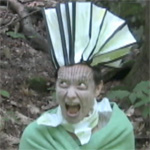 |
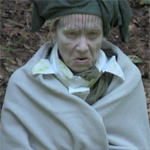 |
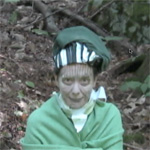 |
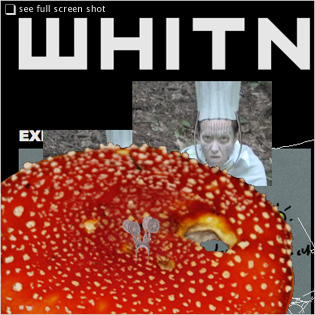 |
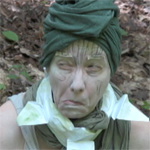 |
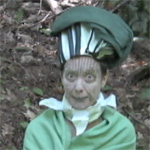 |
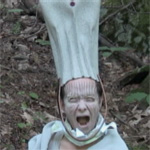 |
| Different mushroom characters... | Click above to view a screenshot of the piece. |
I have been afraid of mushrooms since childhood. Afraid? You may wonder... Well it's a long story which has nothing to to with the consumption of mushrooms but with mushrooms being thrown at me (for "fun" in some sort of game), followed by slimy "gilly" mushroom parts
being stuck to my shoulder and neck afterwards.
I am thinking of this event as a trigger for my first - and only - paranoia. I could not even look at a picture of a mushroom or go near a real mushroom, unless I completely blocked out any emotion.
So, this piece confronted me with a lot of "old" emotional stuff, which I finally addressed, while reenacting the role of different mushroom characters, "becoming" them and dressing up as them (especially painting the gills under the
cap onto my forehead, yeix!).
Another very therapeutic encounter was a filming session in the woods in Upstate New York after abundant rain fall this September. I went
screaming through the woods with a camera in front of my eye... I feel better now. Maybe in the far, far future I might try a dish that contains mushrooms, but that's a different story...
+ + + + + + + + + + + + + + + + + + + + + + + + + + + + +
Light Network: Spiderweb (@ Sunrise)
We are invited onto a spider's web at daybreak and witness the phenomena within and around this network. The spider creature (played by myself) performs different data dances
according to the changes in her habitat, which is defined by New York City weather and CO2 levels.
Depending on the current wind direction and wind speed in New York City the spider web - with the spider (video) in it - is blown into a specific location on the museum's website.
The spider is also reacting to the wind direction within the video.
Higher CO2 levels will trigger more mosquitos buzzing around near the spider web.
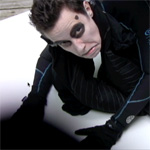 |
 |
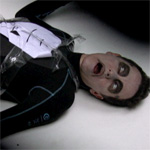 |
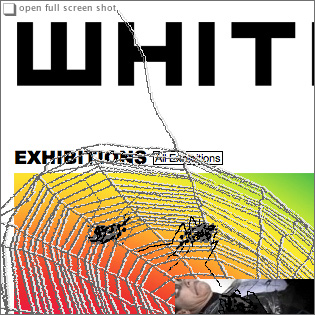 |
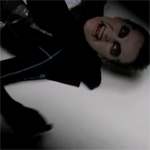 |
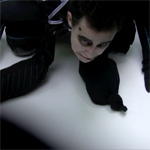 |
 |
| The spider character during different wind directions. | Click above to view a screenshot of the piece. |
I assume the majority of readers here can somehow relate to the fear of spiders or spiderwebs. There's been a variety of movies out there about arachnophobia; these movies were always
hard to watch for me. Spending time in the woods in Upstate New York though helped with overcoming that particular fear a bit.
In order to play a spider I had to research on spiders to a very detailed degree, such as how their faces look and how their legs are anatomically anchored in their bodies.
As a kid I almost fell down a cliff being so shocked by the sudden appearance of a spider web with a large spider sitting in it, as the sun came suddenly out behind the clouds and brightly illuminated the web...
Almost like in Java-Script/HTML, the layer was suddenly switched to visible... and there it was very close in front of my face... I managed to stay on top of the waterfall cliff...
So, becoming a spider while mimiking their looks and behavior has brought me close to them in a more relaxed approach ...
+ + + + + + + + + + + + + + + + + + + + + + + + + + + + +
Technical background: A PHP program accesses current weather and CO2 information and triggers different compositions of Java-scripted animations within HTML layers and videos.
Credits:
Concept, Videos, Sound, Graphics, Web Code: Ursula Endlicher
PHP, Web Code: David Farine
Video Performances: Ursula Endlicher
Real time CO2 and Weather data provided by Wade R. McGillis and Diana Hsueh, Lamont Doherty Earth Observatory, Columbia University, New York.
Thank you to Lee Day and Ernst Endlicher for photographing mushrooms for me, some of which are used for the floating mushroom caps.
+ + + + + + + + + + + + + + + + + + + + + + + + + + + + +
|




